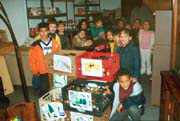Putting food on the table is becoming more difficult for many families. Out of necessity, more of them are turning to local food banks for assistance.
April Harris, coordinator of the Hoboken-based In Jesus’ Name Ministry, knows the problem quite well. She started working at the pantry over 22 years ago and said Monday that she has never had this many problems keeping up with the demand.
“The situation is dire,” said Harris. “Right now the demand is more than we can handle – quite frankly, we’re overwhelmed.”
The reasons for the increase in demand are the faltering economy and its accompanying job cuts and wage freezes. Besides bringing people to the food pantries, they also force consumers to donate less or sometimes not at all.
“Four years ago, we would have 60 families a month that needed emergency assistance; now it’s more like 75 families a week,” Harris said. “I’ve seen more mothers crying, worried that they won’t be able to feed their children, than I’ve ever seen before.”
In Jesus’ Name Ministries was founded by a network of local of Catholic and Protestant churches, as well as a group of local houses of worship (Catholic, Protestant and Jewish) who band together as the Hoboken Clergy Coalition. In Jesus’ Name provides food, clothing and other aid to the poor families in Hoboken.
A national crisis
The struggles of local food pantries, according to recent numbers, are reaching epidemic proportions nationwide. America’s Second Harvest, the nation’s largest hunger relief organization, served nearly 25 million people last year, and checks of food pantries across the country show a 10 to 15 percent increase in demand across the board.
Demand for emergency food rose dramatically from 2001 to 2002 in about 25 cities polled late last year by the U.S. Conference of Mayors. Requests for food jumped 52 percent in Kansas City, 49 percent in Miami, 28 percent in Chicago, 25 percent in Los Angeles, 14 percent in Cleveland and 10 percent in New Orleans.
Agriculture Department experts peg the number of hungry or “food insecure” people at about 34 million, up from about 30 million in 1995. Hunger and food insecurity are defined broadly, as when people are forced to skip a meal or cut back on what they eat because they lack money, when people don’t know where their next meal is coming from, or when people must visit a soup kitchen or food pantry for emergency assistance.
Harris said the reasons for the increased demand can also be linked to changes in the government’s welfare policy. In the past decade, the government shifted to charities the job of making food available to the poor, unemployed, disabled and housebound. According to Census figures, in the mid 1990s welfare reform pushed about 50 percent of some 13 million recipients off the welfare roles and into the workforce when the economy boomed and job creation soared.
But then the economy headed south, and the first jobs cut were those of low wage-earners. Reforms in welfare with more stringent regulations and cuts in federal and state aid have made it harder for the recently unemployed to gain benefits.
“Sure 50 percent are now off welfare, but it’s not like they just disappeared,” said Harris. When jobs were plentiful, the system worked better, she said.
“We need to create work if [the government] wants to continue its commitment to changing our social services system,” said Harris. “Job creation really is the key.”
A different type of clientele
Harris said that the food pantry has in the past serviced primarily the prototypical impoverished populations, i.e. persons who are chronically unemployed, disabled, seniors that can not provide for themselves, or homeless persons.
Today she said the demographics of the people that use the food pantry are very different. The ranks of the hungry more and more include single mothers stuck in low-wage jobs, married couples who can’t keep up with soaring housing costs, and able-bodied people who just can’t find jobs.
“The gap in between jobs just seems to get longer and longer,” said Harris, “and because of that, cupboards of churches, food banks and food pantries across the state and across the country are depleted and are in danger of going out of business.”
For those that want to give, In Jesus’ Name Ministry will be holding a food drive today (Sunday, Nov. 23) at Our Lady of Grace Church at 400 Willow Ave. The church will open all day. If you are not able to drop off non-perishable food items Sunday, contact Harris at (201) 792-2112 to arrange a drop-off. See sidebar for information on the city of Hoboken’s own new food pantry.
Sidebar
City jumps in
Noting the need for food pantries, the city government has jumped in to help. The city of Hoboken has established a food pantry at Iglesia Del Avivamiento/Center for Family Need at 1312 Hudson St.
The food pantry will provide a bag of non-perishable grocery items to local community members in need of assistance.
A wide variety of canned, boxed and frozen foods are distributed every Tuesday from 10 a.m. to 1 p.m. Some of the items that may be available are soup, pasta, instant potato mixes, cereal, crackers, canned vegetables, canned fruit, canned tuna, canned stew, juice and peanut butter.
According to city Director of Human Services Carmelo Garcia, each week, the program has been providing food packages for up to 50 local families.
The program, which is just a month old, was created by the Department of Human Services, the Office of Hispanic and Minority Affairs, the American Red Cross and the Middlesex County Economic Opportunities Corp., a non-profit organization that is state and federally funded.
The program is open to only to Hoboken residents. For information about eligibility requirements or to learn how to donate food or to volunteer, call the Department of Human Services at (201) 420-2012.
